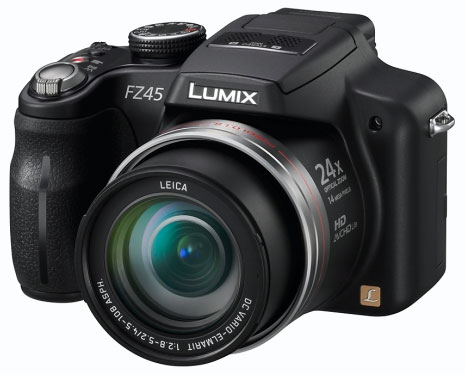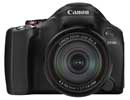Panasonic Lumix DMC-FZ45 / FZ40
-
-
Written by Gordon Laing
Verdict
Panasonic’s Lumix FZ45 / FZ40 is the much-awaited update to the highly popular Lumix FZ38 / FZ35. As you’d expect, Panasonic has inevitably boosted the pixel count giving the FZ45 / FZ40 a 14 Megapixel CCD sensor. In better news, the zoom lens has been extended to 24x providing a little extra coverage at the wide angle end and more telephoto reach with a 25-600mm range. The LCD panel has been upgraded to 3 inches, but unlike its big rival from Canon, remains fixed and there’s still no flash hotshoe either.
Beyond the headline improvements there’s a raft of other changes that improve the overall handling not least of which is the rearrangement of the physical controls and the move from a switch to a button for selecting shooting or playback modes. The movie recording button has been relocated to the top panel, the lens hood redesigned with a new more fool-proof bayonet fixing, the lens cap no longer blocks the lens on power-up, and there’s now the option to shoot fine quality JPEGs with RAW files.
What’s really different this time round though is Panasonic now offers two versions of its super-zoom camera. There’s the FZ45 / FZ40 reviewed here, but for those who enviously looked at Canon’s articulated screen and flash hotshoe, there’s the new FZ100 which adds both of these key features, along with 1080p video and quicker continuous shooting thanks to its CMOS sensor. So which is best for you? The core features of the FZ45 / FZ40, the pricier, but better-featured FZ100, or of course the big rival from Canon, the PowerShot SX30 IS? Let’s see how all three compare.
 | |
Compared to Panasonic Lumix FZ100
 | ||
Panasonic’s decision to produce a premium version of the FZ45 / FZ40 in the form of the Lumix FZ100 is an interesting one. If you’ve been holding off buying the FZ38 / FZ35, waiting to see what the new model has to offer you now have two options.
The FZ45 / FZ40 has a lot to offer over the FZ38 / FZ35 it replaces, not least of which is the extra zoom range. But if your budget can stretch that little bit further, the FZ100 adds an articulated screen, flash hotshoe, 1080p video and faster continuous shooting. While these extras inevitably increase the price, it remains close to that of Canon’s PowerShot SX30 IS.
The one disappointment with the Lumix FZ100 though is the quality of the still images produced by its 14 Megapixel CMOS sensor. The 100 percent crops from our test shots were universally soft and lacking in detail. Pixel-peepers be warned, but for general viewing and printing, it may not be as big an issue as it looks at 100%. Certainly unless you display these images at high magnification on a big screen or print them larger than A3 size, you’re unlikely no notice a huge difference.
If you’re willing to accept some graininess, you can also turn down the noise reduction to avoid some of the softness, or better still, shoot in RAW and tweak the settings later for the desired results.
Look out for our Panasonic Lumix DMC-FZ100 review for more details.
Compared to Canon PowerShot SX30 IS
The stand-out advantage provided by the PowerShot SX30 IS’s enormous 35x optical zoom lens is hard to understate.
At the wide-angle end of the range there may be nothing in it with the two cameras producing virtually identical results, but an 840mm telephoto will get you a lot closer to the action than 600mm, so if you shoot a lot of very distant subjects, this alone will probably be enough to decide you in the PowerShot SX30IS’s favour. The SX30 IS also boasts a flash hotshoe and an articulated screen.
While the FZ45 / FZ40’s screen is fixed in position though, it is larger, and even though there’s no flash hotshoe, it does boast RAW recording facilities – something which Canon still only reserves for its top-end compacts.
HD video fills more of the wider screen of the Lumix FZ45 / FZ40 and with AVCHD Lite as well as Motion JPEG formats to choose from, not to mention the ability to use manual and semi-auto exposure modes, it’s a more versatile video camera than the PowerShot SX30 IS overall.
Lastly, let’s not forget that the Lumix FZ45 / FZ40 is considerably cheaper than the PowerShot SX30 IS, so all that additional telephoto reach on the Canon comes at a price. Added to which, in our outdoor resolution and high ISO noise tests, the Lumix FZ45 / FZ40 produced comparable results to the PowerShot SX30 IS, while again sporting optional RAW recording. The FZ45 / FZ40 is smaller and lighter, while boasting a longer battery life too.
Like their predecessors, the choice boils down to which features and styling are more important to you, but the extra-long zoom range of the SX30 IS, coupled with its articulated screen and flash hotshoe, have already made it another big-seller for Canon. See our Canon PowerShot SX30 IS review for more details.
Panasonic Lumix DMC-FZ45 / FZ40 verdict
The Panasonic Lumix FZ45 / FZ40 improves upon its best-selling predecessor in a number of important areas, most notably the lens range. In the shadow of the Powershot SX30 IS it’s easy to overlook the FZ45 / FZ40’s new 24x optical zoom. It may not be as long as the Canon, but it does offer wider and much longer coverage than the earlier FZ38 / FZ35 – and the 600mm maximum will be more than sufficient for most photographers.
For videographers, the new 3in screen provides a much better view for HD 16:9 movie shooting. Yes, it’s fixed, but on models like the Lumix FZ100 and PowerShot SX30 IS you’d be surprised how often the screen gets turned, locked back into the body and left there. We’re not saying an articulated screen isn’t useful, just that you need to ask yourself how much you’re likely to use it. Don’t forget, all these models have an electronic viewfinder and if you use the one on the Lumix FZ45 / FZ40 exclusively, you’ll get 580 shots before you need to change the battery. As for image quality, the FZ45 / FZ40 wasn’t actually any better in our tests than its predecessor, but it certainly wasn’t any worse.
So which super-zoom camera should you buy of these three new models? The FZ45 / FZ40 is certainly the most affordable by a comfortable margin, not to mention the lightest too. As always it boils down to comparing features and being honest with yourself over which ones really count to you personally. The pricier Lumix FZ100 and PowerShot SX30 IS both feature flash hotshoes and articulated screens, while the FZ100 additionally boasts 1080p video and faster continuous shooting. Some will however rule-out the FZ100 based on its somewhat soft image quality using the default settings, in which case its down to the two old rivals. If you value RAW recording, a lighter body and longer battery life over a flash hotshoe and articulated screen – and of course if a 24x zoom is long enough – then the Lumix FZ45 / FZ40 is the one for you. Like its predecessor, it delivers a very compelling package for the price and comes Highly Recommended.
|
Good points 24x optical zoom with decent stabilisation. ‘Shooting priority’ playback button. Long battery life and compact body. Bayonet mount lens hood included.  Bad points | Scores (relative to 2010 super-zooms) | |||
Build quality: Image quality: Handling: Specification: Value: Overall:
|
18 / 20 16 / 20 16 / 20 17 / 20 18 / 20 85% | |||





